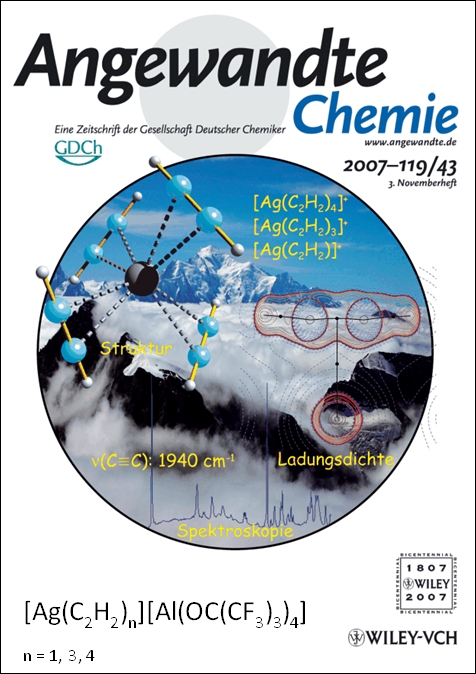Homoleptic Silver(I) acetylene complexes
A. Reisinger, N. Trapp, I. Krossing, S. Altmannshofer, V. Herz, M. Presnitz , W. Scherer, Angew. Chem. Int. Ed. 2007, 46, 8295-8298:
…When a solution of Ag[Al(OC(CF3)3)4] (Ag[A]) in CH2Cl2 is treated with acetylene, cooling of the concentrated, clear, colorless solution to -25°C results in the precipitation of quantitative yields of product as large colorless blocks. If three equivalents acetylene are used, [Ag(η2-C2H2)3][A] (1) is formed, and [Ag (η2-C2H2)4][A] (2) is formed in an atmosphere of acetylene. The solid-state structure of 1 consists of well-separated cations and anions. The Ag+ ion is coordinated by three C2H2 molecules with approximate C2 symmetry. According to quantum-chemical calculations, this initially unexpected structure is isoenergetic [28] to the optimized structure of the higher-symmetry D3 global minimum.[29] The final preference for the reduced symmetry of the observed C2 structure may be caused by seven weak H···F contacts in the range from 2.139 to 2.848 Å. Compound 2 also forms an ionic lattice in which Ag and Al reside on the crystallographic 4 positions. Ag+ is tetrahedrally coordinated by four HCΞCH molecules (d(Ag-C)av =2.497 Å) and the overall cation structure has 4 point-group symmetry. The present structures may be seen in analogy to the recently published [Ag(η2-C2H4)3 ]+ salt.[21]
[21] I. Krossing, A. Reisinger, Angew. Chem. 2003, 115, 5903; Angew. Chem. Int. Ed. 2003, 42, 5725.
[28] Erel(C2)=+1 (BP86/TZVPP) and +2 (MP2/TZVPP)kJ mol-1.
[29] I. Krossing, A. Reisinger, Coord. Chem. Rev. 2006, 250, 2721.


